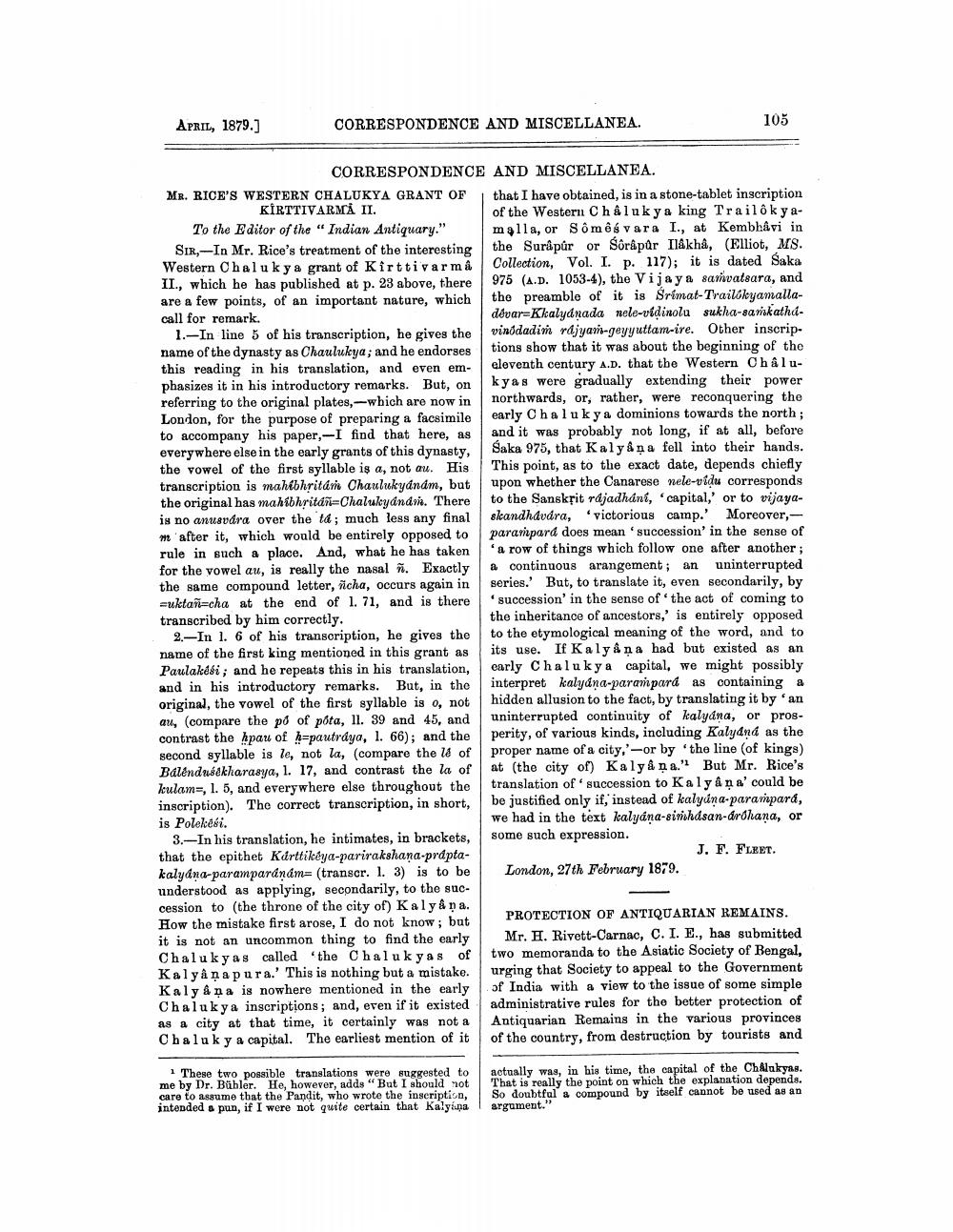________________
APRIL, 1879.]
CORRESPONDENCE AND MISCELLANEA.
105
CORRESPONDENCE AND MISCELLANEA. MR. RICE'S WESTERN CHALUKYA GRANT OF that I have obtained, is in a stone-tablet inscription KIRTTIVARMÅ II.
of the Western Chalukya king Trailôk yaTo the Editor of the "Indian Antiquary." molla, or Somês vara I., at Kembhavi in Sir.-In Mr. Rice's treatment of the interesting the Suråpúr or Sorapur Ilåkha, (Elliot, MS. Western Chaluky a grant of Kirttivarma Collection, Vol. I. p. 117); it is dated Saka II., which he has published at p. 23 above, there 975 (A.D. 1053-4), the Vijaya sanatsara, and are a few points, of an important nature, which the preamble of it is Srímat-Trailókyamallacall for remark.
dóvar=Kkalyanada nele-vidinolu sukha-sankatha1.-In line 5 of his transcription, he gives the vinodadir rdjyam-geyyuttam-ire. Other inscripname of the dynasty as Chaulukya; and he endorses tions show that it was about the beginning of the this reading in his translation, and even em- eleventh century A.D. that the Western Châluphasizes it in his introductory remarks. But, on kyas were gradually extending their power referring to the original plates, which are now in northwards, or, rather, were reconquering the London, for the purpose of preparing a facsimile early Chaluky a dominions towards the north; to accompany his paper, -I find that here, as and it was probably not long, if at all, before everywhere else in the early grants of this dynasty, Saka 975, that Kalyan a fell into their hands. the vowel of the first syllable is a, not au. His This point, as to the exact date, depends chiefly transcription is mahibhritári Chaulukyandm, but upon whether the Canarese nele-vidu corresponds the original has mahibhritan-Chalukyandh. There to the Sanskpit rdjadhání, capital,' or to vijayais no anusvára over the ta; much less any final skandhaudra, 'victorious camp. Moreover, m after it, which would be entirely opposed to parampard does mean 'succession' in the sense of rule in such a place. And, what he has taken 'a row of things which follow one after another; for the vowel au, is really the nasal ñ. Exactly a continuous arangement; an uninterrupted the same compound letter, richa, occurs again in series. But, to translate it, even secondarily, by muktañ=cha at the end of 1. 71, and is there succession in the sense of the act of coming to transcribed by him correctly.
the inheritance of ancestors,' is entirely opposed 2.-In l. 6 of his transcription, he gives the to the etymological meaning of the word, and to name of the first king mentioned in this grant as its use. If Kalyana had but existed as an Paulakési; and he repeats this in his translation, carly Chalukya capital, we might possibly and in his introductory remarks. But, in the interpret kalyana-parampara as containing a original, the vowel of the first syllable is 0, not hidden allusion to the fact, by translating it by an au, (compare the pů of pota, 11. 39 and 45, and uninterrupted continuity of kalydna, or progcontrast the kpart of h=pautrdya, l. 66); and the perity, of various kinds, including Kalyand as the second syllable is le, not la, (compare the ld of proper name of a city,'-or by the line (of kings) Balêndusekharasya, 1. 17, and contrast the la of at (the city of) Kalyana." But Mr. Rice's
ulam=, 1. 5. and everywhere else throughout the translation of succession to Kalyana' could be inscription). The correct transcription, in short, be justified only if, instead of kalyana-parampard, is Polekesi.
we had in the text kalyana-siviihdsan-ardhana, or 3.-In his translation, he intimates, in brackets, some such expression. that the epithet Kárttikéya-parirakshana-prdpta
J. F. FLEET. kalyana-paramparanám= (transcr. l. 3) is to be London, 27th February 1879. understood as applying, secondarily, to the succession to the throne of the city of) Kaly&ņa. How the mistake first arose, I do not know; but
PROTECTION OF ANTIQUARIAN REMAINS. it is not an uncommon thing to find the early
Mr. H. Rivett-Carnac, C. I. E., has submitted Chalu ky as called the Chalukyas of two memoranda to the Asiatic Society of Bengal, Kalyanapura.' This is nothing but a mistake. urging that Society to appeal to the Government Kalyana is nowhere mentioned in the early of India with a view to the issue of some simple Chalukya inscriptions; and, even if it existed administrative rules for the better protection of as a city at that time, it certainly was not a Antiquarian Remains in the various provinces Chaluky a capital. The earliest mention of it of the country, from destruction by tourists and
1 These two possible translations were suggested to me by Dr. Bühler. He, however, adds "But I should not care to assume that the Pandit, who wrote the inscription, intended a pun, if I were not quite certain that Kalyana
actually was, in his time, the capital of the Chalukyas. That is really the point on which the explanation depends. So doubtful & compound by itself cannot be used as an argument."




